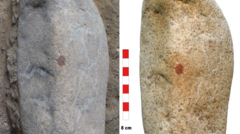Scientists in Spain have revealed the oldest known human fingerprint on a pebble that appears to depict a human face, suggesting Neanderthals possessed the capacity for symbolic thought and artistic expression. The discovery, made in the San Lázaro rock shelter, not only indicates that Neanderthals used red pigment for artistic purposes but also marks a significant finding in the ongoing exploration of prehistoric human creativity.
Discovery of Neanderthal Artwork Transforms Understanding of Early Human Creativity

Discovery of Neanderthal Artwork Transforms Understanding of Early Human Creativity
The unearthing of a 43,000-year-old rock in Spain with a human fingerprint signals the possibility of Neanderthal artistic expression, challenging previous perceptions of their capabilities.
Scientists in Spain have made a groundbreaking discovery that challenges the long-held view of Neanderthals as primitive beings lacking artistic expression. A research team uncovered what they believe to be the oldest full human fingerprint on a rock shaped like a face, dating back around 43,000 years. This pebble, found in the San Lázaro rock shelter in Segovia, indicates that Neanderthals may have dipped their fingers in red pigment to create a nose-like dot, suggesting an ability for abstract thought and symbolic behavior.
The discovery was led by Prof. María de Andrés-Herrero from the University of Complutense in Madrid, and excavations have been underway at the site for five years. In 2022, the team uncovered the pebble just below 1.5 meters (5 feet) of sediment that contained remnants from Neanderthal groups. Prof. de Andrés-Herrero recounted their surprise upon finding the stone, which appeared larger than other artifacts at the site, adorned with a striking red dot akin to a human face.
Initially uncertain whether the dot was created with ochre, the research team later confirmed it was a pigment and sought the assistance of Spain's scientific police for advanced testing. Their multi-spectrum analysis revealed not only the presence of a fingerprint—believed to belong to an adult male—but also highlighted the lack of comparison references for more data on Neanderthal fingerprints.
Spanish official Gonzalo Santonja emphasized the significance of the pebble, calling it "the oldest portable object to be painted on the European continent" and the singular instance of painted portable art by Neanderthals. This revelation adds a layer to the ongoing debate surrounding Neanderthals' capacity for symbolic thought.
Prof. de Andrés-Herrero noted that the findings contribute substantially to the discourse on Neanderthals' artistic capabilities, with the dot found in an artistic rather than utilitarian context, showcasing intentional creative expression. It is believed that a Neanderthal discovered the stone, which intrigued him due to its peculiar fissures, and he purposefully marked it with an ochre stain.
Researchers assert that the intentionality behind the mark is supported by the fact that the red pigment was not naturally found at the shelter. In their paper published in the journal Archaeological and Anthropological Sciences, they characterize the pebble as a potential visual symbol and a piece of portable art, underscoring its exceptional nature within the archaeological framework. The notion that Neanderthals engaged in artistic practices repositions our understanding of their cognitive and cultural capabilities, inviting further exploration into the creative dimensions of prehistoric life.





















